The United States launched Operation Prosperity Guardian, a multilateral naval operation involving the United Kingdom, Canada, France, Bahrain, Norway, and Spain. Oil tycoon BP has temporarily stopped shipping any crude along the route; rival energy tycoon Shell has not yet responded.
Oil Prices
Attacks on commercial ships in the Red Sea have triggered fears of increasing oil prices, which might increase the cost of oil and, accordingly, other items.
The Red Sea, a crucial global route for oil, liquefied natural gas, and consumer goods, is being targeted by Houthi rebels who support Hamas in its conflict with Israel. The rebels, based in Yemen, are targeting vessels believed to be heading towards Israel, with some firms reporting attacks from drones and missiles.
Ship attacks have escalated, with some firms reporting drone and missile attacks. Rerouting of ships will impact 12% of global trade, worth $1 trillion annually, as the Red Sea is the hub for about $1 trillion worth of goods. German firm Hapag-Lloyd requires 100% assurance of the Red Sea’s safety for ships to return. Rerouting could increase shipping costs, congestion at ports, and delays. However, experts predict some disruptions and delays, not a complete supply chain disruption.
US Dollar
The US dollar is softer in the initial hours after the US opening bell on Tuesday, with markets disregarding comments from European Central Bank (ECB) and Federal Reserve speakers.
The US Dollar Index is heading lower towards 102, with no safe haven inflow occurring after Monday’s events. Economically, the Housing Data is not helping, with no big moves and even contractions in Building Permits.
Geopolitical tensions in the Red Sea are easing fast, with major freight shipping companies deviating their float from the region, leading to longer and more expensive travel routes via Africa, and inflationary pressures for January for consumers.
The Federal Reserve and ECB are trying to backtrack on earlier statements that rate cuts for 2024 are not on the cards, with the Bank of Japan likely missing its window of opportunity to hike out of negative rates. Asian equities are welcoming the standstill at the BoJ, while European and US equities are going sideways.
The CME Group’s FedWatch Tool shows that markets are pricing in a 91.7% chance that the Federal Reserve will keep interest rates unchanged at its January 31 meeting.

 Noor Trends News, Technical Analysis, Educational Tools and Recommendations
Noor Trends News, Technical Analysis, Educational Tools and Recommendations




